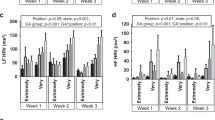Abstract
Recent research suggests supine positioning for sleeping infants is the safest position to prevent breathing related difficulties; however doing so can significantly increase obstruction in apneic infants resulting in decreased sleep quality. We implemented a multi-component treatment package compromised of antecedent interventions and parent-mediated social reinforcement to increase lateral positioning in a premature infant with obstructive sleep apnea. Results indicate that the intervention increased lateral positioning in the participant by over 80 % in the final phase of the study, indicating efficacy of the intervention. Limitations and suggestions for future research are discussed.

Similar content being viewed by others
References
Afrashi, A., & Ucar, Z. (2015). Effect of prone positioning in mild to moderate obstructive sleep apnea syndrome. Sleep & Breathing, 19(3), 1027–1034.
Bacher, M., Sautermeister, J., Urschitz, M., Buchenau, W., Arand, J., & Poets, C. (2011). An oral appliance with velar extension for treatment of obstructive sleep apnea in infants with Pierre robin sequence. Cleft Palate-Craniofacial Journal, 48(3), 331–336.
Bhat, R., Hannam, S., Pressler, R., Rafferty, G., Peacock, J., & Greenough, A. (2006). Effect of prone and supine position in sleep, apneas, and arousal in preterm infants. Pediatrics, 118(1), 101–107.
Hauck, F. R., Tanabe, K. O., McMurry, T., & Moon, R. Y. (2015). Evaluation of bedtime basics for babies: a national crib distribution program to reduce the risk of sleep-related sudden infant deaths. Journal of Community Health, 40(3), 457–463.
Goffinski, A., Stanley, M. A., Shepherd, N., Duvall, N., Jenkinson, S. B., Davis, C., et al. (2015). Obstructive sleep apnea in young infants with Down syndrome evaluated in a Down syndrome specialty clinic. American Journal of Medical Genetics Part A, 167(2), 324–330.
House, A., House, B., & Campbell, M. (1981). Measures of interobserver agreement: calculation formulas and distribution effects. Journal of Behavioral Assessment, 3(1), 37–57.
Kadey, H., & Roane, H. (2012). Effects of access to a stimulating object on infant behavior during tummy time. Journal of Applied Behavior Analysis, 45(2), 395–399.
Katz, E., Mitchell, R., & D’Ambrosio, C. (2012). Obstructive sleep apnea in infants. American Journal of Respiratory and Critical Care Medicine, 185(8), 805–816.
McMullen, S. (2013). Transitioning premature infants to supine: state of the science. American Journal of Maternal Child Nursing, 38(1), 8–12.
Menon, A., & Kumar, M. (2013). Influence of body position on severity of obstructive sleep apnea: a systematic review. ISRN Otolaryngology, 2013, 1–7.
Ortega, R., & Fienup, D. M. (2015). Effects of a preferred stimulus and mother’s attention on infant behavior during tummy time. Behavior Analysis in Practice, 8(1), 66–69.
Pogliani, L., Mameli, C., Fabiano, V., & Zuccotti, G. V. (2011). Positional plagiocephaly: what the pediatrician needs to know. A review. Child's Nervous System, 27(11), 1867–1876.
Acknowledgments
We would like to thank our young participant as well as his family for their continued participation.
Author information
Authors and Affiliations
Corresponding author
Ethics declarations
Conflict of Interest
The authors declare that they have no conflict of interest.
Informed Consent
Informed consent was obtained from the parents of all individual participants included in the study.
Additional information
Summary for Clinicians
• A single case analysis was completed with a premature infant suffering obstructive sleep apnea using a rigorous, multi-element treatment package.
• Antecedent manipulations such as placement of a stimulus are generally simple to implement, yet effective in increasing socially valid behavioral outcomes while, in this study, also increasing physiologically necessary outcomes.
• Utility of behavioral methods is effective in various populations and can be advantageous beginning in early infancy.
• Parent attention when combined with other manipulations is effective for shaping sleeping posture in infants.
Rights and permissions
About this article
Cite this article
Voulgarakis, H., Forte, S., Giacomelli, C. et al. Effects of Antecedent Manipulations and Social Reinforcement to Increase Lateral Positioning in a Premature Infant with Obstructive Sleep Apnea. Behav Analysis Practice 10, 83–86 (2017). https://doi.org/10.1007/s40617-016-0141-0
Published:
Issue Date:
DOI: https://doi.org/10.1007/s40617-016-0141-0




